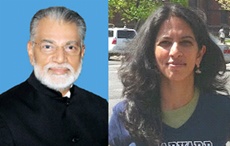Isro chief Radhakrishnan, computer scientist Radhika Nagpal among Nature’s top 10 scientists
26 Dec 2014
K Radhakrishnan, the chairman of the Indian Space Research Organisation, has been named by the journal Nature as one of the top 10 people that mattered in science in 2014. He is probably the first Indian working in India to have been picked by the reputed journal.
 Nature picked the scientist for successfully leading ISRO's first interplanetary mission Mangalyaan, which was inserted into the Martian orbit on 24 September.
Nature picked the scientist for successfully leading ISRO's first interplanetary mission Mangalyaan, which was inserted into the Martian orbit on 24 September.
Nature said that as head of ISRO, Radhakrishnan would have been aware that half the attempts to reach Mars have ended in failure. ''But the ISRO had taken lessons from other countries' mistakes, and it set modest aims for its first interplanetary mission, which it billed as a technology demonstration,'' it said.
Another person of Indian origin, Radhika Nagpal - a researcher who used biology-inspired robotics to get a swarm of 1,024 robots to assemble and form various shapes - was among the top ten.
The other eight are:
Andrea Accomazzo, a former test pilot who was flight director of the European Space Agency's Rosetta mission, which has for the first time put a spacecraft in orbit around a comet and soft-landed Philae spacecraft on it;
Suzanne Topalian, a clinician who helped pioneer PD-1 inhibitors, a new class of drug therapy for cancer. The drugs allow T-cells in the immune system to freely attack tumours.
Sheik Humarr Khan, an infection disease expert from Sierra Leone, who became a part of a team of scientists who carried out the first genetic sequencing studies of the Ebola virus. He helped treat many Ebola patients as lead physician at Sierra Leone's Kenema Government Hospital, but himself succumbed to the disease in July this year;
David Spergel: The astrophysicist who spotted an error in the evidence provided by a team of scientists that they had probably detected gravitational waves from space;
Maryam Mirzakhani, the first female mathematician to win the Fields Medal, the equivalent of a Nobel in mathematics;
Pete Frates, a former university baseball coach who started the Ice-Bucket challenge that gained worldwide attention this year and raised $115 million for combating amyotrophic lateral sclerosis, a neuro-degenerative disorder;
Masayo Takahashi, an ophthalmologist, who successfully tested the safety and efficacy of using induced pluripotent stem (iPS) cells, which are adult cells genetically reprogrammed to an embryonic stem cell, to treat blindness;
Sjors Scheres, a biologist who developed a software called RELION, which can produce extremely detailed 3D reconstructions of molecular machines which are components of molecules responsible for mechanical movement. This can help scientists visualise molecular machines more clearly than was possible before.













.jpg)






.jpg)









